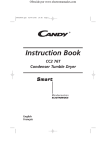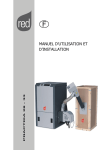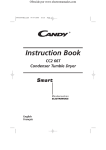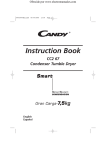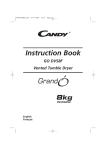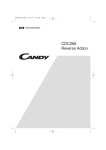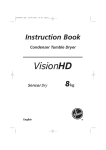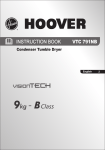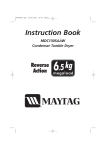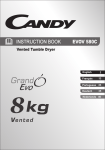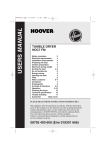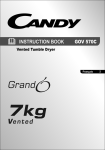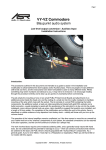Download Candy GO DC 68G Specifications
Transcript
40005612Eng.qxd 07/07/2008 16:12 Page 1 ® Instruction Book GO DC 68G Condenser Tumble Dryer English Français 40005612Eng.qxd 07/07/2008 16:12 Page 2 English . . . . . . . . . . . . . . . . . . . . . . . . . . . . . . . . . . . . . . . . . . . . 2 Français . . . . . . . . . . . . . . . . . . . . . . . . . . . . . . . . . . . . . . . . . . . 20 Introduction ...............................................3 Delivery information . . . . . . . . . . . . . . . . . . . . . . . . . . . . . . . . . . . . . . . . . . . . . 3 Unpacking the Product . . . . . . . . . . . . . . . . . . . . . . . . . . . . . . . . . . . 3 Safety reminders . . . . . . . . . . . . . . . . . . . . . . . . . . . . . . . . . . . . . . . . . . 4 Installation . . . . . . . . . Use . . . . . . . . . . . . . . . The Laundry . . . . . . . . Environmental Issues . GIAS Service . . . . . . . . . . . . . . . . . . . . . . . . . . . . . . . . . . . . . . . . . . . . . . . . . . . . . . . . . . . . . . . . . . . . . . . . . . . . . . . . . . . . . . . . . . . . . . . . . . . . . . . . . . . . . . . . . . . . . . . . . . . . . . . . . . . . . . . . . . . . . . . . . . . . . . . . . . . . . . . . . . . . . . . . . . . . . . . . . . . . . . . . . . . . . . . . . . . . . . . . . . . . . . . . . . . . . . . . . . . . . . . . . . . . 4 4 4 5 5 Installation . . . . . . . . . . . . . . . . . . . . . . . . . . . . . . . . . . . . . . . . . . . . . . . . . 6 Electrical requirements . . . . . . . . . . . . . . . . . . . . . . . . . . . . . . . . . . . . . . . . . . . 6 Adjusting the feet . . . . . . . . . . . . . . . . . . . . . . . . . . . . . . . . . . . . . . . . . . . . . . . 6 Ventilation . . . . . . . . . . . . . . . . . . . . . . . . . . . . . . . . . . . . . . . . . . . . . . . . . 7 Preparing the load . . . . . . . . . . . . . . . . . . . . . . . . . . . . . . . . . . . . . . . . 8 Clothes preparation . . . . . . . . . . . . . . . . . . . . . . . . . . . . . . . . . . . . . . . . . . . . . . 8 Sorting the load. . . . . . . . . . . . . . . . . . . . . . . . . . . . . . . . . . . . . . . . . . . . . . . . . 9 Drying advice . . . Do not tumble dry . . . . Energy saving. . . . . . . . Drying guide . . . . . . . . . . . . . . . . . . . . . . . . . . . . . . . . . . . . . . . . . . . . . . . . . . . . . . . . . . . . . . . . . . . . . . . . . . . . . . . . . . . . . . . . . . . . . . . . . . . . . . . . . . . . . . . . . . . . . . . . . . . . . . . . . . . . . . . . . . . . . . . . . . . . . . . . . . . . . . . . . . . . . . . . . . . . . . . . 10 10 10 10 Controls and indicators . . . . . . . . . . . . . . . . . . . . . . . . . . . . . . . . . 11 Door and Filter . . . . . . . . . . . . . . . . . . . . . . . . . . . . . . . . . . . . . . . . . . . 12 Opening the door . . . . . . . . . . . . . . . . . . . . . . . . . . . . . . . . . . . . . . . . . . . . . . 12 Filter. . . . . . . . . . . . . . . . . . . . . . . . . . . . . . . . . . . . . . . . . . . . . . . . . . . . . . . . . 12 Filter care indicator . . . . . . . . . . . . . . . . . . . . . . . . . . . . . . . . . . . . . . . . . . . . . 12 Water container . . . . . . . . . . . . . . . . . . . . . . . . . . . . . . . . . . . . . . . . . . 13 To remove the container . . . . . . . . . . . . . . . . . . . . . . . . . . . . . . . . . . . . . . . . . 13 Condenser . . . . . . . . . . . . . . . . . . . . . . . . . . . . . . . . . . . . . . . . . . . . . . . . 14 To remove the condenser . . . . . . . . . . . . . . . . . . . . . . . . . . . . . . . . . . . . . . . . 14 Selecting the Programme . . . . . . . . . . . . . . . . . . . . . . . . . . . . . . . 14 Operation . . . . . . . . . . . . . . . . . . . . . . . . . . . . . . . . . . . . . . . . . . . . . . . . . 16 Cancelling and resetting the programme . . . . . . . . . . . . . . . . . . . . . . . . . . . . 16 Start Delay . . . . . . . . . . . . . . . . . . . . . . . . . . . . . . . . . . . . . . . . . . . . . . . . . . . . 16 Cleaning and Routine Maintenance . . . . . . . . . . . . . . . . . . . . 17 Cleaning the dryer . . . . . . . . . . . . . . . . . . . . . . . . . . . . . . . . . . . . . . . . . . . . . . 17 Technical specifications . . . . . . . . . . . . . . . . . . . . . . . . . . . . . . . . . . . . . . . . . . 17 Troubleshooting . . . . . . . . . . . . . . . . . . . . . . . . . . . . . . . . . . . . . . . . . . 18 Customer Service . . . . . . . . . . . . . . . . . . . . . . . . . . . . . . . . . . . . . . . . . 19 Spares. . . . . . . . . . . . . . . . . . . . . . . . . . . . . . . . . . . . . . . . . . . . . . . . . . . . . . . . 19 GIAS Service . . . . . . . . . . . . . . . . . . . . . . . . . . . . . . . . . . . . . . . . . . . . . . . . . . . 19 2 40005612Eng.qxd 07/07/2008 16:13 Page 3 Introduction Please read and follow these instructions carefully and operate the machine accordingly. This booklet provides important guidelines for safe use, installation, maintenance and some useful advice for best results when using your machine. Check that no damage has occurred to the machine during transit. If it has, call for service by GIAS. Keep all documentation in a safe place for future reference or for any future owners Delivery information Please check that the following items are delivered with the appliance: ● Instruction manual ● Guarantee card ● Energy label Failure to comply with the above can compromise the safety of the appliance. You may be charged for a service call if a problem with your machine is caused by misuse. Unpacking the product Remove the machine from its packaging close to the final location of the machine. 1. Cut carefully around the base of the packaging and up one corner. 2. Remove the polythene sleeve and lift the dryer off the polystyrene base. Dispose of the packaging safely. Make sure it is out of the reach of children, it is a potential source of danger. 3 40005612Eng.qxd 07/07/2008 16:13 Page 4 Safety reminders Installation ● ● ● ● Check that the product has no visible signs of damage before use. If damaged do not use and please call GIAS Service. Do not use adapters, multiple connectors and/or extensions. Never install the dryer against curtains and be sure to prevent items from falling or collecting behind the dryer. The appliance must not be installed behind a lockable door, a sliding door or a door with a hinge on the opposite side to that of tumble dryer. Use ● ● ● ● ● ● ● ● ● ● ● ● ● ● This appliance is not intended for use by persons (including children) with reduced physical, sensory or mental capabilities, or lack of experience and knowledge, unless they have been given supervision or instruction concerning use of the appliance by a person responsible for their safety. Children should be supervised to ensure that they do not play with the appliance. WARNING Misuse of a tumble dryer may create a fire hazard. This machine is solely for domestic use, i.e. to dry household textiles and garments. This machine should only be used for its intended purpose as described in this manual. Ensure that the instructions for installation and use are fully understood before operating the appliance. Do not touch the appliance when hands or feet are damp or wet. Do not lean on the door when loading the machine or use the door to lift or move the machine. Do not allow children to play with the machine or its controls. WARNING Do not use the product if the fluff filter is not in position or is damaged; fluff could be ignited. WARNING Where the hot surface symbol is located the temperature rise during operation of the tumble dryer may be in excess of 60 degrees C. Remove the plug from the electricity supply. Always remove the plug before cleaning the appliance. Do not continue to use this machine if it appears to be faulty. Lint and fluff must not be allowed to collect on the floor around the outside of the machine. The drum inside may be very hot. Always allow the dryer to complete the cool down period before removing the laundry. The Laundry ● ● ● ● ● 4 Do not dry unwashed items in the tumble dryer. WARNING Do not tumble dry fabrics treated with dry cleaning fluids. WARNING Foam rubber materials can, under certain circumstances, when heated become ignited by spontaneous combustion. Items such as foam rubber (latex foam), shower caps, waterproof textiles, rubber backed articles and clothes or pillows fitted with foam rubber pads MUST NOT be dried in the tumble dryer. Always refer to the laundry care labels for directions on suitability for drying. Clothes should be spin dried or thoroughly wrung before they are put into the 40005612Eng.qxd ● ● ● ● 07/07/2008 16:14 Page 5 tumble dryer. Clothes that are dripping wet should NOT be put into the dryer. Lighters and matches must not be left in pockets and NEVER use flammable liquids near the machine. Glass fibre curtains should NEVER be put in this machine. Skin irritation may occur if other garments are contaminated with the glass fibres. Items that have been soiled with substances such as cooking oil, acetone, alcohol, petrol, kerosene, spot removers, turpentine, waxes and wax removers should be washed in hot water with an extra amount of detergent before being dried in the tumble dryer. Fabric softeners, or similar products, should be used as specified by the fabric softener instructions. Environmental Issues ● ● All packaging materials used are environmentally-friendly and recyclable. Please help dispose of the packaging via environmentally-friendly means. Your local council will be able to give you details of current means of disposal. To ensure safety when disposing of an old tumble dryer disconnect the mains plug from the socket, cut the mains power cable and destroy this together with the plug. To prevent children shutting themselves in the machine break the door hinges or the door lock. GIAS Service ● To ensure the continued safe and efficient operation of this appliance we recommend that any servicing or repairs are only carried out by an authorised GIAS Service engineer. European directive 2002/96/EC This appliance is marked according to the European directive 2002/96/EC on Waste Electrical and Electronic Equipment (WEEE). By ensuring this product is disposed of correctly, you will help prevent potential negative consequences for the environment and human health, which could otherwise be caused by inappropriate waste handling of this product. The symbol on the product indicates that this product may not be treated as household waste. Instead it shall be handed over to the applicable collection point for the recycling of electrical and electronic equipment Disposal must be carried out in accordance with local environmental regulations for waste disposal. For more detailed information about treatment, recovery and recycling of this product, please contact your local city office, your household waste disposal service or the shop where you purchased the product. If the appliance is not running properly or breaks down, switch it off and disconnect the plug from the socket. Consult GIAS Service for possible repair. 5 40005612Eng.qxd 07/07/2008 16:14 Page 6 Installation You may be charged for a service call if a problem with your machine is caused by incorrect installation. Electrical requirements Tumble dryers are supplied to operate at a voltage of 230V, 50 Hz single phase. Check that the supply circuit is rated to at least 10A. Electricity can be extremely dangerous. This appliance must be earthed. The socket outlet and the plug on the appliance must be of the same type. Do not use multiple adapters and/or extension leads. If the mains cord on this appliance is damaged, it must be replaced by a special cord which is ONLY obtainable from the spares service. It must be installed by a competent person. The plug should be accessible for disconnection after the appliance has been installed. The wires in the mains lead are coloured in accordance with the following codes: Blue NEUTRAL Brown LIVE Green and Yellow EARTH CE Appliance complies with European Directive 89/336/EEC, 73/23/EEC and subsequent amendments. Do not plug the machine in and switch it on at the mains until the installation is completed. For your safety, this dryer must be correctly installed. If there is any doubt about installation, call GIAS Service for advice. Adjusting the feet Once the machine is in place the feet should be adjusted to ensure that the machine is level. 6 40005612Eng.qxd 07/07/2008 16:14 Page 7 Ventilation Adequate ventilation must be provided in the room where the tumble dryer is located to prevent gases from appliances burning other fuels, including open fires, being drawn into the room during operation of the tumble dryer. ● Exhaust air must not be discharged into a flue which is used for exhausting fumes from appliances burning gas or other fuels. ● Check regularly that the air flowing through the dryer is not restricted. ● Check the fluff filter after use, and clean, if necessary. ● The inlet and outlets should be kept free from obstructions. To ensure adequate ventilation the space between the bottom of the machine and the floor must not be obstructed. There should be a gap of at least 12mm between the machine and any obstructions. ● Prevent items from falling or collecting behind the dryer as these may obstruct the air inlet and outlet. ● NEVER install the dryer up against curtains. AIR INLET VENTS AIR OUTLETS AIR OUTLETS IN THE BASE 7 40005612Eng.qxd 07/07/2008 16:14 Page 8 Preparing the load Before using the tumble dryer for the first time: ● Please read this instruction book thoroughly. ● Remove all items packed inside drum. ● Wipe the inside of the drum and door with a damp cloth to remove any dust which may have settled in transit. Clothes preparation Make sure that the laundry you are going to dry is suitable for drying in a tumble dryer, as shown by the care symbols on each item. Do not overload the drum, large items when wet can exceed the maximum admissible clothes load (for example: sleeping bags, duvets). 8 Check that all fastenings are closed and that pockets are empty. Turn the articles inside out. Place clothes loosely in the drum to make sure that they don't get tangled. Maximum drying weight ● Cottons Max. 8 kg ● Synthetics Max. 4 kg 40005612Eng.qxd 07/07/2008 16:14 Page 9 Sort the load as follows: ● By care symbols These can be found on the collar or inside seam: Suitable for tumble drying. Tumble drying at high temperature. Tumble drying at low temperature only. Do not tumble dry. If the item does not have a care label it must be assumed that it is not suitable for tumble drying. ● By amount and thickness Whenever the load is bigger than the dryer capacity, separate clothes according to thickness (e.g. towels from thin underwear). ● By type of fabric Cottons/linen: Towels, cotton jersey, bed and table linen. Synthetics: Blouses, shirts, overalls, etc. made of polyester or polyamid, as well as for cotton/synthetic mixes. ● By drying level Sort into: iron dry, cupboard dry, etc. For delicate articles press the ‘Séchage Délicat’ button to select low drying temperature. 9 40005612Eng.qxd 07/07/2008 16:14 Page 10 Drying advice IMPORTANT: Do not dry articles which have been treated with a dry cleaning fluid or rubber clothes (danger of fire or explosion). During the last 15 minutes the load is always tumbled in cool air. Do not tumble dry: Woollens, silk, delicate fabrics, nylon stockings, delicate embroidery, fabrics with metallic decorations, garments with PVC or leather trimmings, training shoes, bulky items such as sleeping bags, etc. Energy saving Only put into the tumble dryer laundry which has been thoroughly wrung or spin-dried. The drier the laundry the shorter the drying time thus saving electricity. ALWAYS ● Try to dry the maximum weight of laundry, this will save time and electricity. ● Check that the filter is clean before every drying cycle. NEVER ● Exceed the maximum weight, this will waste time and electricity. ● Put dripping wet items into the tumble dryer, this may damage the appliance. Drying guide The table shows approximate drying times, depending on the type of fabric and dampness of the clothes. 10 40005612Eng.qxd 07/07/2008 16:22 Page 11 Controls and indicators EMPTY WATER INDICATOR (Réservoir Plein) PROGRAMME SELECTOR ACRYLICS/ SYNTHETICS BUTTON (Séchage Délicat) COUNTDOWN DISPLAY START BUTTON (Départ) FILTER CARE INDICATOR (Entretien Filtre) START DELAY BUTTON (Départ Différé) ON/OFF BUTTON (Marche Arrêt) Control panel and indicator lights Programme Selector – Select the required programme ‘Marche Arrêt’ button and indicator – Press to switch on, the indicator will light ‘Départ’ – Press Départ to commence the selected drying programme. Press for 5 seconds to cancel/reset the programme ‘Séchage Délicat’ button – Press to reduce the heat level for delicate items, the indicator above the button will light up. To change the heat setting the programme must be reset Low Heat – Indicator light ON High Heat – Indicator light OFF ‘Réservoir Plein’ indicator – Lights when the water container is full ‘Entretien Filtre’ indicator – Lights when the filter needs cleaning ‘Départ Différé’ button – Allows the user to delay the start of the drying cycle (see details of operation page 17) Display START – When the dryer is switched On the START indicator will flash, when the programme starts the START indicator will light up 60' – Indicator lights when there is less than 60 minutes left until completion of the programme 15' - Indicator lights when there is less than 15 minutes left until completion of the programme. At this stage of the drying cycle the machine enters the Cool Down phase STOP - Indicator lights when the programme is finished 6h - 6 hour start delay (light flashes when in operation) 9h - 9 hour start delay (light flashes when in operation) 11 40005612Eng.qxd 07/07/2008 16:14 Page 12 Door and Filter Opening the door Pull on handle to open the door. To restart the dryer, close the door and press Départ. WARNING! When the tumble dryer is in use the drum and door may be VERY HOT. Never stop a tumble dryer before the end of the drying cycle unless all items are quickly removed and spread out so that the heat is dissipated. Filter IMPORTANT: To maintain the efficiency of the dryer check that the fluff filter is clean before each drying cycle. 1. Pull the filter upwards. 2. Open filter as shown. 3. Gently remove lint using a soft brush or your fingertips. 4. Snap the filter together and push back into place. Filter Care Indicator ‘Entretien Filtre’ lights when the filter needs cleaning. If the laundry is not drying check that the filter is not clogged. 12 40005612Eng.qxd 07/07/2008 16:14 Page 13 Water Container The water removed from the laundry during the drying cycle is collected in a container at the bottom of the dryer. When the container is full the ‘Réservoir Plein’ indicator on the control panel will light, and the container MUST be emptied. However, we recommend that the container is emptied after each drying cycle. NOTE: Very little water will collect during the first few cycles of a new machine as an internal reservoir is filled first. To remove the container 1. Gently pull the bottom of the kickplate so that it unclips from the dryer. The top section can then be unhinged allowing the kickplate to be completely removed. 2. Pull firmly on the handgrip and slide the water container out of the dryer. Support the container with both hands. When full, the water container will weigh about 4kg. 3. Open the lid located on the top of the container and empty the water. 4. Refit the lid and slide the water container back into position. PUSH FIRMLY INTO PLACE. 5. Refit the kickplate by engaging the hinges at the top and 'snapping' the lower clips into place. 13 40005612Eng.qxd 07/07/2008 16:14 Page 14 Condenser Important: Always switch off and remove the plug from the electricity supply before cleaning the condenser. To maintain the efficiency of the dryer regularly check that the condenser is clean. To remove the condenser 1. Remove the kickplate (see page 13). 2. Turn the two locking levers anti-clockwise and pull out the condenser. 3. Pull out the condenser unit. 4. Gently remove any dust or fluff with a cloth, then wash the unit by holding it under a running tap turning it so that water flows between the plates, to remove any dust or fluff. 5. Refit the condenser ensuring it is in the correct way (as indicated by the arrow) and pushed firmly into place. Lock the two levers by turning them clockwise. 6. Refit the kickplate. Selecting the Programme The Sensor Dry machine gives many options for drying the laundry to suit all circumstances. Note: The sensor may not detect a small load of small articles. For small loads and separate items or pre-dried fabrics with low moisture 14 40005612Eng.qxd 07/07/2008 16:14 Page 15 content, use the timed programmes. Set the programme between 30 and 75 minutes depending on the load size and dryness required, and select high or low heat depending upon the fabric type. If the sensor does not detect the item the dryer will only operate for 10 minutes before going into cooldown. If the load is too large or too wet to tumble dry the dryer will automatically go into cooldown after 185 minutes. The table below lists the programmes and the function of each programme. Programme Drying (A ranger) Iron Dry (Prêt à repasser) Description Select the degree of dryness that you require. This ranges from for bath towels and bathrobes, through for items that will be put away without ironing, to the programme that leaves the laundry suitable for ironing. Wool (Laine) A gentle programme specially created to get woollens softer after air-drying. This delicate warm air cycle, lasting 12 minutes, can also be used to get woollens 'refreshed' after being stored in the wardrobe. Fast Iron (Repassage facile) The Fast Iron programme provides a conditioning and anticrease function. The dryer will heat the load for 9 minutes followed by a 3 minute cool down period and is especially good for garments which may have been left for some time prior to ironing, in a linen basket for example. Garments may also become stiffened when dried outside on a washing line or inside on radiators. The Fast Iron process relaxes the creases in the fabric making ironing quicker and easier. 120' 120 minutes of drying 75' 75 minutes of drying 60' 60 minutes of drying 45' 45 minutes of drying 30' 30 minutes of drying FROID Tumbling of laundry in cool air for 30 minutes 15 40005612Eng.qxd 07/07/2008 16:14 Page 16 Operation 1. 2. 3. 4. 5. 6. 7. 8. 9. 10. 11. Open the door and load the drum with laundry. Ensure that garments do not hinder closure of the door. Gently close the door pushing it slowly until you hear the door 'click' shut. Press the ‘Marche Arrêt’ button to switch on the dryer. The indicator will light up and the START indicator will flash. Turn the Programme Selector dial to select the required drying programme (see Programme Guide). If drying synthetics, acrylics or delicate items, press the ‘Séchage Délicat’ button to reduce the heat level. The light above the push button will light up when the machine is in low heat setting. To deselect this status when the drying cycle has started it is necessary to reset the machine. Press the ‘Départ’ button. The dryer will start automatically and the START indicator will be continuously lit. The display will show the drying progress in terms of time remaining. If the door is opened during the programme to check the laundry, it is necessary to press ‘Départ’ to recommence drying after the door has been closed. When the 15' indicator is lit the machine will enter the cool down phase, the clothes will be tumbled in cool air allowing the load to cool down. When the programme is complete the STOP indicator will light. Following the completion of the cycle the drum will rotate intermittently to minimise creasing. This will continue until the machine is reset or switched OFF. Cancelling and resetting the programme To cancel a programme switch the machine off and on again. The machine will indicate that it has been reset by the START indicator flashing. Buzzer Operation The buzzer will operate when the selector is rotated and when function buttons are pressed. To cancel the operation of the buzzer, follow this sequence. Press and hold on the Acrylic/Synthetic (Séchage Délicat) and Start (Départ) buttons and then turn the machine ON using the ON/OFF switch (Marche Arrêt). To switch the buzzer back on repeat the above sequence. 16 40005612Eng.qxd 07/07/2008 16:14 Page 17 Start Delay The ‘Départ Différé’ function allows the user to delay the start of the drying cycle by 6 or 9 hours. When the function is first selected the display will show a delay of 6 hours, a subsequent press of the button will increase the delay to 9 hours. To commence the programme press ‘Départ’ and the appliance will complete the drying cycle at the end of this time. The 6 or 9 hour indicator light will flash to indicate that the start delay is in progress. WARNING! The drum, door and load may be very hot. Cleaning and Routine Maintenance Cleaning the dryer ● Clean the filter and empty the water container after every drying cycle. ● Regularly clean the condenser. ● After each period of use, wipe the inside of the drum and leave the door open for a while to allow circulation of air to dry it. ● Wipe the outside of the machine and the door with a soft cloth. ● DO NOT use abrasive pads or cleaning agents. ● To prevent the door sticking or the build up of fluff periodically clean the inner door and gasket with a damp cloth. Technical specifications Drum capacity 115 litres Maximum load 8 kg Height 85cm Width 60cm Depth 60cm Energy Label Band B IMPORTANT Always switch off and remove the plug from the electricity supply before cleaning this appliance. For electrical data refer to the rating label on the front of the dryer cabinet (with the door open). 17 40005612Eng.qxd 07/07/2008 16:14 Page 18 Troubleshooting What might be the cause of... Defects you can remedy yourself Before calling GIAS Service for technical advice please run through the following checklist. A charge will be made if the machine is found to be working or has been installed incorrectly or used incorrectly. If the problem persists after completing the recommended checks, please call GIAS Service, they may be able to assist you over the telephone. Drying time is too long/clothes are not dry enough… ● ● ● ● ● ● ● Have you selected the correct drying time/programme? Were the clothes too wet? Were the clothes thoroughly wrung or spindried? Does the filter need cleaning? Does the condenser need cleaning? Is the dryer overloaded? Are the inlets, outlets and base of the dryer free from obstructions? Has the ‘Séchage Délicat’ option been selected from a previous cycle? The dryer does not operate… ● ● ● ● ● ● ● ● ● Is there a working electricity supply to the dryer? Check using another appliance such as a table lamp. Is the plug properly connected to the mains supply? Is there a power failure? Has the fuse blown? Is the door fully closed? Is the dryer switched on, both at the mains supply and at the machine? Has the drying time or the programme been selected? Has the machine been switched on again after opening the door? Has the dryer stopped operating because the water tray is full and needs emptying? The dryer is noisy… ● Switch off the dryer and contact GIAS Service for advice. The ‘Entretien Filtre’ Indicator is on… ● ● Does the filter need cleaning? Does the condenser need cleaning? The ‘Réservoir Plein’ Indicator is on… ● 18 Does the water container need emptying? 40005612Eng.qxd 07/07/2008 16:14 Page 19 Customer Service Should there still be a problem with your dryer after completing all the recommended checks, please call GIAS Service for advice. They may be able to assist you over the telephone or arrange for a suitable appointment for an engineer to call under the terms of your guarantee. However, a charge may be made if any of the following applies to your machine: ● Is found to be in working order. ● Has not been installed in accordance with the installation instructions. ● Has been used incorrectly. Spares Always use genuine spares, available direct from GIAS Service. GIAS Service For service and repairs call your local GIAS Service engineer. The manufacturer declines all responsibility in the event of any printing mistakes in this booklet. The manufacturer also reserves the right to make appropriate modifications to its products without changing the essential characteristics. 19 40005612Fre.qxd 09/07/2008 13:01 Page 20 Introduction . . . . . . . . . . . . . . . . . . . . . . . . . . . . . . . . . . . . . . . . . . . . . . 21 Informations sur la livraison . . . . . . . . . . . . . . . . . . . . . . . . . . . . . . . . . . . . . . 21 Déballage du produit . . . . . . . . . . . . . . . . . . . . . . . . . . . . . . . . . . . . 21 Rappels de sécurité . . . . . . . . . . . . . . . . . . . . . . . . . . . . . . . . . . . . . . 22 Installation . . . . . . . . . . . . . . . . Utilisation. . . . . . . . . . . . . . . . . Le linge . . . . . . . . . . . . . . . . . . Protection de l’environnement Service GIAS . . . . . . . . . . . . . . . . . . . . . . . . . . . . . . . . . . . . . . . . . . . . . . . . . . . . . . . . . . . . . . . . . . . . . . . . . . . . . . . . . . . . . . . . . . . . . . . . . . . . . . . . . . . . . . . . . . . . . . . . . . . . . . . . . . . . . . . . . . . . . . . . . . . . . . . . . . . . . . . . . . . . . . . . . . . . . . . . . . . . . . . . . . . . . . . . . . . 22 22 22 23 23 Installation . . . . . . . . . . . . . . . . . . . . . . . . . . . . . . . . . . . . . . . . . . . . . . . . 24 Besoins électriques. . . . . . . . . . . . . . . . . . . . . . . . . . . . . . . . . . . . . . . . . . . . . . 24 Ajustement des pieds. . . . . . . . . . . . . . . . . . . . . . . . . . . . . . . . . . . . . . . . . . . . 24 Ventilation . . . . . . . . . . . . . . . . . . . . . . . . . . . . . . . . . . . . . . . . . . . . . . . . 25 Préparation de la charge . . . . . . . . . . . . . . . . . . . . . . . . . . . . . . . . 26 Préparation des vêtements . . . . . . . . . . . . . . . . . . . . . . . . . . . . . . . . . . . . . . . 26 Tri de la charge . . . . . . . . . . . . . . . . . . . . . . . . . . . . . . . . . . . . . . . . . . . . . . . . 27 Conseils de séchage. . Ne séchez pas en machine . . . . Économies d’énergie . . . . . . . . Guide de séchage. . . . . . . . . . . . . . . . . . . . . . . . . . . . . . . . . . . . . . . . . . . . . . . . . . . . . . . . . . . . . . . . . . . . . . . . . . . . . . . . . . . . . . . . . . . . . . . . . . . . . . . . . . . . . . . . . . . . . . . . . . . . . . . . . . . . . . . . . . . . . . . . . . . . . . . . . . . 28 28 28 28 Commandes et indicateurs . . . . . . . . . . . . . . . . . . . . . . . . . . . . . 29 Porte et filtre . . . . . . . . . . . . . . . . . . . . . . . . . . . . . . . . . . . . . . . . . . . . . 30 Ouverture de la porte . . . . . . . . . . . . . . . . . . . . . . . . . . . . . . . . . . . . . . . . . . . 30 Filtre. . . . . . . . . . . . . . . . . . . . . . . . . . . . . . . . . . . . . . . . . . . . . . . . . . . . . . . . . 30 Indicateur Entretien Filtre . . . . . . . . . . . . . . . . . . . . . . . . . . . . . . . . . . . . . . . . 30 Réservoir d’eau . . . . . . . . . . . . . . . . . . . . . . . . . . . . . . . . . . . . . . . . . . . 31 Pour retirer le réservoir . . . . . . . . . . . . . . . . . . . . . . . . . . . . . . . . . . . . . . . . . . 31 Condenseur . . . . . . . . . . . . . . . . . . . . . . . . . . . . . . . . . . . . . . . . . . . . . . . 32 Pour retirer le condenseur . . . . . . . . . . . . . . . . . . . . . . . . . . . . . . . . . . . . . . . . 32 Sélection du programme . . . . . . . . . . . . . . . . . . . . . . . . . . . . . . . . 32 Fonctionnement . . . . . . . . . . . . . . . . . . . . . . . . . . . . . . . . . . . . . . . . . 34 Annulation et réinitialisation du programme . . . . . . . . . . . . . . . . . . . . . . . . . 34 Départ Différé . . . . . . . . . . . . . . . . . . . . . . . . . . . . . . . . . . . . . . . . . . . . . . . . . 34 Nettoyage et Entretien de Routine . . . . . . . . . . . . . . . . . . . . 35 Nettoyage du sèche-linge . . . . . . . . . . . . . . . . . . . . . . . . . . . . . . . . . . . . . . . . 35 Spécifications techniques . . . . . . . . . . . . . . . . . . . . . . . . . . . . . . . . . . . . . . . . . 35 Dépistage de pannes . . . . . . . . . . . . . . . . . . . . . . . . . . . . . . . . . . . . 36 Service clientèle . . . . . . . . . . . . . . . . . . . . . . . . . . . . . . . . . . . . . . . . . . 37 Pièces de rechange. . . . . . . . . . . . . . . . . . . . . . . . . . . . . . . . . . . . . . . . . . . . . . 37 Service GIAS . . . . . . . . . . . . . . . . . . . . . . . . . . . . . . . . . . . . . . . . . . . . . . . . . . . 37 20 40005612Fre.qxd 09/07/2008 13:01 Page 21 Introduction Veuillez lire et suivre ces instructions avec soin et utiliser la machine en conséquence. Ce livret contient des instructions importantes sur la sécurité d’utilisation, l’installation et l’entretien de la machine, ainsi que des conseils utiles pour obtenir les meilleurs résultats possibles lors de son utilisation. Conservez toute la documentation dans un endroit sûr pour pouvoir vous y reporter à une date ultérieure ou la transmettre aux prochains propriétaires Informations sur la livraison Vérifiez que les articles suivants ont bien été livrés avec l’appareil : ● Manuel d’utilisation ● Carte de garantie ● Étiquette d’énergie Vérifiez que la machine ne s’est pas détériorée en transit. Si c’est le cas, contactez GIAS pour une opération de dépannage. Le non-respect de ces instructions peut compromettre la sécurité de votre appareil. Un appel de service peut vous être facturé si la défaillance de votre appareil est causée par une mauvaise utilisation. Déballage du produit Retirez la machine de l’emballage, à proximité de son emplacement définitif. 1. Coupez délicatement autour de la base de l’emballage en remontant vers l’angle supérieur. 2. Retirer le manchon en polyéthylène et sortez le sèche-linge de la base en polystyrène. Mettez l’emballage au rebut en toute sécurité. Conservez hors de portée des enfants car il représente une source de danger potentielle. 21 40005612Fre.qxd 09/07/2008 13:01 Page 22 Rappels de sécurité Installation ● ● ● ● Vérifiez que la machine ne présente aucun signe visible de détérioration avant de l’utiliser. En cas de détérioration, assurez-vous de ne pas l’utiliser et de contacter le service GIAS. N’utilisez pas d’adaptateurs, de multi-prises et/ou de rallonges. Veillez à ne pas installer le sèche-linge contre des rideaux et assurez-vous que rien ne pourra tomber ou s’accumuler derrière le sèche-linge. Cet appareil ne doit pas être installé derrière une porte verrouillable, une porte coulissante ou une porté munie de gonds placée en face de la porte du sèche-linge. Utilisation ● ● ● ● ● ● ● ● ● ● ● ● ● ● Cet appareil ne doit pas être utilisé par des personnes (notamment des enfants) jouissant de capacités mentales, sensorielles ou physiques réduites ou d’un manque d’expérience ou de connaissances, sauf si elles sont surveillées ou ont reçu des instructions concernant l’utilisation de cet appareil par une personne responsable de leur sécurité. Les enfants doivent être surveillés afin de s’assurer qu’ils ne s’amusent pas avec l’appareil. ATTENTION La mauvaise utilisation d’un sèche-linge risque de causer un d’incendie. Cette machine est conçue uniquement pour usage domestique, à savoir pour sécher le linge domestique et les vêtements. Cette machine ne doit être utilisée que pour l’emploi auquel elle est destinée et qui est décrit dans ce manuel. Assurez-vous d’avoir bien compris les instructions d’installation et d’utilisation avant de faire fonctionner la machine. Ne touchez pas la machine si vous avez les mains ou les pieds mouillés ou humides. Ne vous appuyez pas sur la porte lorsque vous chargez la machine et n’utilisez pas la porte pour soulever ou déplacer la machine. Ne laissez pas des enfants jouer avec la machine ou avec ses commandes. ATTENTION N’utilisez pas cette machine si le filtre à peluches n’est pas en place ou s’il est endommagé ; les peluches risquent en effet de s’allumer. ATTENTION L’augmentation de température pendant le fonctionnement du sèche-linge peut être supérieure à 60°C là où se trouve le symbole de surface chaude . Débranchez du courant de secteur. Retirez toujours la prise avant de nettoyer la machine. Cessez d’utiliser la machine si elle semble défectueuse. Veillez à ce que les peluches ne puissent pas s’accumuler sur le sol, à l’extérieur de la machine. Il se peut que l’intérieur du tambour soit très chaud. Veillez à ce que le sèche-linge termine son cycle de refroidissement avant d’en sortir le linge. Le linge ● ● ● ● 22 Ne séchez pas des vêtements non lavés dans le sèche-linge. ATTENTION NE séchez PAS les tissus qui ont été traités avec des liquides de nettoyage à sec. ATTENTION Quand elles sont chauffées, les mousses alvéolaires peuvent dans certains cas brûler par combustion spontanée. Les articles tels que le caoutchouc mousse (mousse de latex), les bonnets de douche, le textile imperméable, les articles caoutchoutés et les vêtements ou coussins rembourrés de caoutchouc mousse NE DOIVENT PAS être séchés dans le sèche-linge. Reportez-vous toujours aux étiquettes d’entretien du linge pour vérifier le mode de séchage recommandé. 40005612Fre.qxd ● ● ● ● ● 09/07/2008 13:02 Page 23 Les vêtements doivent être essorés en machine ou à la main avant d’être placés dans le sèchelinge. Les vêtements qui dégoulinent NE DOIVENT PAS être mis dans le sèche-linge. Enlevez les briquets et les allumettes des poches et veillez à ne JAMAIS utiliser de liquides inflammables à proximité de la machine. Les rideaux en fibres de verre ne doivent JAMAIS être placés dans cette machine. La contamination d’autres vêtements par les fibres de verre peut entraîner des irritations de la peau. Les articles qui ont été souillés par des substances telles que huile de cuisson, acétone, alcool, pétrole, kérosène, produit anti-taches, térébenthine, cire et décapant pour cire doivent être lavés à l’eau chaude avec une quantité supplémentaire de détergent avant d’être séchés dans le sèchelinge. Les agents adoucissants, et autres produits similaires, doivent être utilisés conformément aux instructions fournies par le fabricant du produit. Protection de l’environnement ● ● Tous les matériaux de conditionnement utilisés sont écologiques et recyclables. Veuillez les éliminer de manière écologique. Votre municipalité pourra vous donner le détail exact des méthodes d’élimination en vigueur. Pour assurer la sécurité lors de l’élimination d’un vieux sèche-linge, veuillez débrancher la fiche du courant de secteur, couper le câble d’alimentation et le détruire avec la fiche. Pour empêcher que les enfants ne s’enferment dans la machine, cassez les charnières de la porte ou son dispositif de verrouillage. Service GIAS ● Pour veiller au fonctionnement efficace et sans risque de cet appareil, nous vous recommandons de faire exclusivement appel à un technicien GIAS agréé pour son entretien ou sa réparation éventuelle. Directive européenne 2002/96/CE Cet appareil est commercialisé en accord avec la directive européenne 2002/96/CE sur les déchets des équipements électriques et électroniques (DEEE). En vous assurant que ce produit est correctement recyclé, vous participez à la prévention des conséquences négatives sur l’environnement et la santé publique qui pourrait être causé par une mise au rebut inappropriée de ce produit. Le symbole sur ce produit indique qu’il ne doit pas être traité comme un déchet ménager. Il doit être rapporté jusqu’à un point de recyclage des déchets électriques et électroniques. La collecte de ce produit doit se faire en accord avec les réglementations environnementales concernant la mise au rebut de ce type de déchets. Pour plus d’information au sujet du traitement, de la collecte et du recyclage de ce produit, merci de contacter votre mairie, votre centre de traitement des déchets ou le magasin où vous avez acheté ce produit. Si l’appareil ne fonctionne pas correctement ou s’il tombe en panne, mettez-le à l’arrêt et débranchez-le du courant de secteur. Consultez le service GIAS pour prévoir une éventuelle réparation. 23 40005612Fre.qxd 09/07/2008 13:02 Page 24 Installation Un appel de service peut vous être facturé si la défaillance de votre appareil est causée par une installation incorrecte. Besoins électriques Les sèche-linges sont prévues pour une tension monophasée de 230 V, 50 Hz. Vérifiez que la tension nominale du circuit d’alimentation est réglée sur 10 A minimum. L’électricité peut être extrêmement dangereuse. Cet appareil doit être mis à la terre. La prise de courant et la fiche de la machine doivent être du même type. N’utilisez pas de multi-prises et/ou de rallonges. La fiche doit être accessible pour débrancher l’appareil une fois qu’il a été installé. Si le cordon électrique de cet appareil est endommagé, il doit être remplacé par un cordon spécial qui est UNIQUEMENT disponible auprès du service des pièces de rechange. Il doit être installé par une personne compétente. Les fils du câble de secteur sont colorés en fonction des codes suivants : Bleu NEUTRE Marron SOUS TENSION Vert et jaune TERRE La machine est conforme aux directives européennes 89/336/EEC, 73/23/EEC et à leurs modifications ultérieures. Ne branchez pas l’appareil et ne mettez pas en marche l’interrupteur de secteur tant que l’installation n’est pas terminée. Par mesure de sécurité, veillez à installer ce sèche-linge correctement. En cas de doute concernant son installation, veuillez demander conseil à GIAS Service. Ajustement des pieds Lorsque la machine est en place, les pieds doivent être ajustés pour mettre la machine de niveau. 24 40005612Fre.qxd 09/07/2008 13:02 Page 25 Ventilation La pièce où se trouve le sèche-linge doit avoir une ventilation adéquate de manière à ce que les gaz des appareils qui brûlent d’autres combustibles, y compris les cheminées, ne soient pas attirés dans la pièce pendant que le sèche-linge est en marche. ● L’air d’échappement ne doit pas être évacué par un conduit qui est également utilisé pour évacuer les fumées d’échappement d’appareils qui brûlent du gaz ou d’autres combustibles. ● Vérifiez régulièrement que l’air peut circuler librement autour du sèche-linge. ● Vérifiez le filtre à peluches après usage, et nettoyez-le le cas échéant. ● Les entrées et sorties doivent être libres d’obstructions. Pour veiller à une ventilation adéquate, l’espace entre le bas de la machine et le sol ne doit pas être obstrué. Il doit y avoir un espace d’au moins 12 mm entre la machine et d’éventuelles obstructions. ● Veillez à ce que rien ne puisse tomber ou s’accumuler entre les côtés et l’arrière du sèchelinge, afin de ne pas obstruer l’entrée et la sortie d’air. ● N’installez JAMAIS le sèche-linge contre des rideaux. ENTREES D’AIR PRISES D’AIR PRISES D’AIR DANS LA BASE 25 40005612Fre.qxd 09/07/2008 13:02 Page 26 Préparation de la charge Avant d’utiliser le sèche-linge pour la première fois : ● Veuillez lire ce manuel d’instruction en détail. ● Retirez tous les articles qui se trouvent à l’intérieur du tambour. ● Essuyez l’intérieur du tambour et de la porte avec un chiffon humide pour éliminer la poussière éventuelle qui aurait pu s’y infiltrer en transit. Préparation des vêtements Ne surchargez pas le tambour ; lorsqu’ils sont mouillés, les grands articles peuvent dépasser le poids de maximum admissible (ex : sacs de couchage, couettes). 26 Vérifiez sur les étiquettes comportant les symboles d’entretien que le linge que vous souhaitez sécher convient au séchage en machine. Vérifiez que toutes les fermetures sont fermées et que les poches sont vides. Mettez les articles à l’envers. Placez les vêtements en vrac dans le tambour en veillant à ce qu’ils ne s’emmêlent pas les uns avec les autres. Poids de séchage maximum ● Coton, 8 kg maxi ● Synthétiques, 4 kg maxi 40005612Fre.qxd 09/07/2008 13:02 Page 27 Triez la charge comme suit : ● Par symbole de soin d’entretien Vous les trouverez sur le col ou la couture intérieure : Convient pour séchage en machine. Séchage à haute température. Séchage à basse température uniquement. Ne séchez pas en machine. Si le vêtement ne comporte aucune étiquette de conseils de lavage, considérez qu’il ne convient pas pour le séchage en machine. ● Par quantité et épaisseur Lorsque la charge est plus importante que la capacité du sèche-linge, séparez les vêtements selon leur épaisseur (ex : les serviettes des sousvêtements fins). ● Par type de tissu Coton/toile de lin : Serviettes, jersey en coton, linge de lit ou de table. Synthétiques : Chemisiers, chemises, blouses etc. en polyester ou polyamide, ainsi que pour les mélanges de coton/synthétique. ● Par degré de séchage Triez selon : sec pour repassage, sec pour rangement, etc. Pour les articles délicats, appuyez sur le bouton Séchage Délicat pour sélectionner une température de séchage basse. 27 40005612Fre.qxd 09/07/2008 13:02 Page 28 Conseils de séchage IMPORTANT : Ne séchez pas les articles qui ont été traités avec un liquide de nettoyage à sec ou les vêtements en caoutchouc (risque d’incendie ou d’explosion). Ne séchez pas en machine : Les lainages, la soie, les tissus délicats, les bas de nylon, les broderies délicates, les tissus ayant des décorations métalliques, les vêtements avec des bordures en PVC ou en cuir, les chaussures de sport, les articles volumineux comme les sacs de couchage, etc. Économies d’énergie Ne mettez que du linge essoré en machine ou à la main dans le sèche-linge. Plus le linge est sec, plus le temps de séchage sera court, ce qui économisera de l’énergie. TOUJOURS Pendant les 15 dernières minutes, la charge est toujours séchée dans de l’air froid. ● Essayez de sécher le poids de linge maximum, pour économiser du temps et de l’électricité. ● Vérifiez que le filtre est propre avant chaque cycle de séchage. JAMAIS ● Ne dépassez pas le poids maximum pour ne pas gaspiller du temps ou de l’électricité. ● Ne mettez pas d’articles dégoulinant d’eau dans le sèche-linge pour ne pas endommager l’appareil Guide de séchage Ce tableau indique les temps de séchage approximatifs, selon le type de tissu et le degré d’humidité des vêtements. 28 40005612Fre.qxd 09/07/2008 13:02 Page 29 Commandes et indicateurs INDICATEUR RESERVOIR PLEIN SELECTEUR DE PROGRAMMES BOUTON SÉCHAGE DÉLICAT AFFICHEUR COUNTDOWN BOUTON DÉPART BOUTON DÉPART DIFFÉRÉ INDICATEUR ENTRETIEN FILTRE BOUTON MARCHE ARRÊT Panneau de commande et témoins indicateurs Sélecteur de programmes – sélectionnez le programme requis Bouton et indicateur Marche/Arrêt – appuyez pour mettre en marche ; l’indicateur s’allume Bouton Départ – appuyez sur ce bouton pour lancer le programme de séchage sélectionné. Appuyez pendant 5 secondes pour annuler/réinitialiser le programme. Bouton Séchage Délicat – appuyez pour réduire la température pour les articles délicats ; l’indicateur situé au-dessus du bouton s’allume. Pour modifier le réglage de la température, le programme doit être réinitialisé. Basse température - témoin lumineux ALLUME Haute température - témoin lumineux ETEINT Indicateur Réservoir Plein – s’allume lorsque le réservoir d’eau est plein Indicateur Entretien Filtre – s’allume lorsque le filtre a besoin d’être nettoyé. Bouton Départ Différé – permet à l’utilisateur de différer le démarrage du cycle de séchage (voir les détails de fonctionnement en page 34) Afficheur START – le témoin de START clignote lorsque le sèche-linge est en marche, et est allumé lorsque le programme débute. 60' – le témoin s’allume lorsqu’il reste moins de 60 minutes avant la fin du programme. 15' – le témoin s’allume lorsqu’il reste moins de 15 minutes avant la fin du programme. A ce stade du cycle de séchage, la machine se met en mode Refroidissement STOP – ce témoin s’allume lorsque le programme est terminé. 6h – temporisation de 6 heures (le témoin clignote lorsque cette fonction est activée). 9h – temporisation de 9 heures ((le témoin clignote lorsque cette fonction est activée) 29 40005612Fre.qxd 09/07/2008 13:02 Page 30 Porte et filtre Ouverture de la porte Tirez sur la poignée pour ouvrir la porte. Pour remettre le sèche-linge en marche, fermez la porte et appuyez Départ. ATTENTION ! Lorsque le seche-linge est en cours d’utilisation, il se peut que le tambour et la porte soient TRES CHAUDS. N’arrêtez jamais le sèche-linge avant la fin du cycle de séchage sauf si tous les articles sont rapidement retirés et étendus de façon à dissiper la chaleur. Filtre IMPORTANT : Pour assurer l’efficacité du sèche-linge, vérifiez que le filtre à peluches est propre avant chaque cycle de séchage. 1. Tirez le filtre vers le haut. 2. Ouvrez le filtre, comme illustré. 3. Retirez doucement les peluches à l’aide d’une brosse douce ou du bout des doigts. 4. Réenclenchez le filtre et poussez-le en place. Indicateur Entretien Filtre L’indicateur Entretien Filtre s’allume lorsqu’il faut nettoyer le filtre. Si le linge ne sèche pas, vérifiez que le filtre n’est pas colmaté. 30 40005612Fre.qxd 09/07/2008 13:02 Page 31 Réservoir d’eau L’eau récupérée du linge pendant le cycle de séchage est recueillie dans un bac situé en bas du sèche-linge. Quand le réservoir est plein, l’indicateur ‘Réservoir Plein’ s’allume sur le panneau de commande et le réservoir DOIT ABSOLUMENT être vidé. Cependant, nous recommandons de vider le réservoir après chaque cycle de séchage. NOTE : Il n’y a que très peu d’eau qui est récupéré pendant les premiers cycles d’une nouvelle machine, car le réservoir intérieur est rempli en premier. Pour retirer le réservoir 1. Tirez doucement le bas de la plaque de protection pour la décrocher du sèche-linge. La section supérieure peut être ôtée de ses charnières pour permettre le retrait total de la plaque de protection. 2. Tirez fermement sur la poignée et faites glisser le réservoir d’eau en dehors du sèche-linge. Tenez-le fermement à deux mains. Lorsque le bac est plein, il pèse environ 4 kg. 3. Ouvrez le couvercle qui se trouve sur le dessus du bac et videz l’eau. 4. Refermez le couvercle et glissez le bac de récupération de l’eau en place. POUSSEZ-LE FERMEMENT EN PLACE. 5. Remettez la plaque de protection en place en engageant les charnières du haut et en enclenchant les attaches inférieures en place. 31 40005612Fre.qxd 09/07/2008 13:02 Page 32 Condenseur Important : Coupez toujours le courant et débranchez la prise avant de nettoyer le condenseur. Pour maintenir l’efficacité du sèche-linge, vérifiez régulièrement la propreté du condenseur. Pour retirer le condenseur 1. Retirez la plaque de protection (voir page 31). 2. Tournez les deux leviers de blocage dans le sens contraire des aiguilles d’une montre et retirez le condenseur. 3. Tirez l’ensemble du condenseur vers l’extérieur. 4. Retirez doucement la poussière ou les peluches avec un chiffon, puis lavez-le en le tenant sous un robinet d’eau pour que l’eau coule entre les plaques afin d’enlever la poussière ou les peluches éventuelles. 5. Remettez correctement le condenseur en place (en suivant la flèche) en le poussant fermement. Bloquez les deux leviers en position en les tournant dans le sens des aiguilles d’une montre. 6. Remettez la plaque de protection en place. Sélection du programme La machine Sensor Dry propose diverses options de séchage du linge répondant à tous les besoins. Note : Il se peut que le capteur ne détecte pas les petites charges de petits articles. Pour les petites charges et les articles individuels ou les tissus préséchés ayant une faible teneur en humidité, 32 40005612Fre.qxd 09/07/2008 13:02 Page 33 utilisez les programmes à durée déterminée. Réglez le programme entre 30 et 75 minutes selon la taille de la charge et le degré de séchage voulu, et sélectionnez une température haute ou basse selon le type de tissu. Si le capteur ne détecte pas l’article, le sèche-linge ne fonctionnera que pendant 10 minutes avant de se mettre en mode refroidissement. Si la charge est trop importante ou trop mouillée, le sèche-linge se met automatiquement en mode refroidissement après 185 minutes. Le tableau ci-après répertorie les programmes et leurs fonctions correspondantes. Programme Le séchage (A ranger) Prêt à Repasser Description Sélectionnez le degré de séchage souhaité. Celui-ci s’étend de pour le linge de bain et les peignoirs, à pour les articles qui seront rangés sans être repassés, et comprend également le programme séchant le linge qui sera repassé. Laine (Laine) Un programme délicat spécialement créé pour rendre les lainages plus doux après le séchage à l’air. Ce cycle délicat à l’air chaud, d’une durée de 12 minutes, permet aussi de “rafraîchir” les lainages rangés depuis un certain temps dans votre armoire. Fast Iron (Repassage facile) Le programme Repassage rapide comporte une fonction assouplissant et antifroissement. Le sèche-linge chauffera la charge pendant 9 minutes et le refroidira ensuite pendant 3 minutes, ce qui est particulièrement utile pour les vêtements qui ont été laissés pendant un certain temps avant le repassage, dans le sac à linge par exemple. Les vêtements peuvent également raidir lorsqu’ils sont séchés en plein air sur une corde à linge ou à l’intérieur sur des radiateurs. Le processus de Repassage rapide détend les froissements du tissu pour rendre le repassage plus rapide et plus facile. 120' 120 minutes de séchage 75' 75 minutes de séchage 60' 60 minutes de séchage 45' 45 minutes de séchage 30' 30 minutes de séchage FROID Séchage de linge dans de l’air froid pendant 30 minutes 33 40005612Fre.qxd 09/07/2008 13:02 Page 34 Fonctionnement 1. 2. 3. 4. 5. 6. 7. 8. 9. 10. 11. Ouvrez la porte et chargez le sèche-linge de linge. Vérifiez qu’aucun vêtement n’entrave la fermeture de la porte. Fermez doucement la porte en la poussant lentement jusqu’à ce que vous entendiez un déclic. Appuyez sur le bouton Marche/Arrêt pour mettre le sèche-linge en marche. Le témoin s’allume et le témoin de START clignote. Tournez le sélecteur de programme pour choisir le programme de séchage requis (consultez le guide de programmation). Pour sécher des articles délicats, synthétiques ou en acrylique, appuyez sur le bouton Séchage Délicat pour diminuer la température. Le témoin lumineux situé au-dessus du bouton s’allume lorsque la machine est en mode basse température. Pour désactiver ce mode lorsque le cycle de séchage a commencé, la machine doit être réinitialisée. Appuyez sur le bouton ‘Départ’. Le sèche-linge démarre automatiquement et l’indicateur START reste allumé de façon continue. L’afficheur indique le l’avancement du séchage en termes de temps restant. Si vous ouvrez la porte pendant le cycle de séchage pour vérifier le linge, il est nécessaire d’appuyer sur Départ pour recommencer le séchage une fois la porte refermée. Lorsque l’indicateur 15' s’allume, la machine se met en mode refroidissement et les articles sont séchés dans de l’air froid. Lorsque le programme est terminé, le témoin STOP s’allume. À la fin du cycle, le tambour continuera à tourner de manière intermittente pour minimiser les froissements. Cette opération se poursuit jusqu'à ce que la machine soit réinitialisée ou éteinte. Annulation et réinitialisation du programme Pour annuler un programme, appuyez sur Arrêt puis sur Marche. L'indicateur START clignote, signifiant que la machine a été réinitialisée. Fonctionnement de la sonnerie La sonnerie est activée en tournant le sélecteur et en appuyant sur les boutons de fonction. Pour annuler le déclenchement de la sonnerie, veuillez procéder comme suit. Appuyez sur les boutons Séchage Délicat et Départ et maintenez-les enfoncés, puis mettez en marche la machine en appuyant sur l'interrupteur ON/OFF (Marche Arrêt). Pour réactiver la sonnerie, observez la même procédure que celle qui vient d'être décrite. Départ Différé La fonction de Départ Différé permet à l’utilisateur de programmer le démarrage du cycle de séchage dans un délai de 6 à 9 heures. 34 40005612Fre.qxd 09/07/2008 13:02 Page 35 Lorsque cette fonction est sélectionnée pour la première fois, l’afficheur indique un délai de 6 heures. Il convient d’appuyer une nouvelle fois sur le bouton pour repousser le délai à 9 heures. Pour lancer le programme, appuyez sur Départ. Le cycle de séchage débutera à l’issue de ce délai. Le témoin lumineux de 6 ou 9 heures clignote alors pour indiquer que la temporisation est activée. ATTENTION ! Il est possible que le tambour, la porte et la charge soient très chauds. Nettoyage et entretien de routine Nettoyage du sèchelinge ● ● ● ● ● ● Nettoyez le filtre et videz le réservoir d’eau après chaque cycle de séchage. Nettoyez le condenseur à intervalles réguliers. Après chaque période d’utilisation, essuyez l’intérieur du tambour et laissez la porte ouverte pendant un moment pour qu’il puisse sécher grâce à la circulation d’air. Essuyez l’extérieur de la machine et la porte avec un chiffon doux. N’utilisez PAS de tampons ou d’agents de nettoyage abrasifs. Pour empêcher que la porte n’adhère ou que les peluches ne s’accumulent, nettoyez régulièrement la surface intérieure et le joint de la porte avec un chiffon humide. Spécifications techniques Capacité du tambour 115 litres Charge maximale 8 kg Hauteur 85 cm Largeur 60 cm Profondeur 60 cm Étiquette d’énergie B IMPORTANT Coupez toujours le courant et débranchez la fiche de l’alimentation électrique avant de nettoyer cet appareil. Pour les données électriques, veuillez consulter l’étiquette des valeurs nominales qui se trouve à l’avant de l’armoire du sèche-linge (avec la porte ouverte). 35 40005612Fre.qxd 09/07/2008 13:02 Page 36 Dépistage de pannes Qu’est-ce qui peut être à l’origine de... Défauts que vous pouvez rectifier vous-même Avant d’appeler le service GIAS pour obtenir des conseils, veuillez suivre la liste des vérifications ci-dessous. L’intervention sera facturée si la machine fonctionne correctement ou si elle a été installée ou utilisée de manière incorrecte. Si le problème persiste alors que vous avez terminé les vérifications recommandées, veuillez appeler le service GIAS qui pourra peut-être vous aider par téléphone. La période de séchage est trop longue/les vêtements ne sont pas suffisamment secs… ● ● ● ● ● ● ● Avez-vous sélectionné le temps de séchage/le programme qui convient ? Les vêtements étaient-ils trop mouillés ? Les vêtements avaient-ils été adéquatement essorés en machine ou à la main ? Le filtre doit-il être nettoyé ? Faut-il nettoyer le condenseur ? Le sèche-linge est-il surchargé ? Les entrées, sorties et la base du sèche-linge sont-elles libres d’obstructions ? Avez-vous sélectionné le bouton Séchage Délicat au cours d’un cycle précédent ? Le sèche-linge ne fonctionne pas… ● ● ● ● ● ● ● ● ● Le sèche-linge est-il branché sur une alimentation électrique adéquate ? Vérifiez à l’aide d’un autre appareil, par exemple une lampe de chevet. La fiche est-elle bien branchée sur l’alimentation de secteur ? Y a-t-il une panne de courant ? Le fusible a-t-il sauté ? La porte est-elle bien fermée ? Le sèche-linge est-il en position de marche, au niveau du courant de secteur et de la machine ? La période de séchage ou le programme a-t-il été sélectionné ? La machine a-t-elle été remise en marche après l’ouverture de la porte ? Le sèche-linge s’est-il arrêté parce que le réservoir d’eau est plein et qu’il faut le vider ? Le sèche-linge est bruyant… ● Arrêtez le sèche-linge et contactez le service GIAS pour obtenir des conseils. L’indicateur Entretien Filtre est allumé… ● ● Le filtre doit-il être nettoyé ? Faut-il nettoyer le condenseur ? L’indicateur Réservoir Plein est allumé… ● 36 Le réservoir d’eau doit-il être vidé ? 40005612Fre.qxd 09/07/2008 13:02 Page 37 Service clientèle En cas de problème après avoir effectué toutes les inspections recommandées, veuillez contacter le Service. Il pourra vous aider par téléphone ou organiser la visite d’un technicien, en vertu des conditions de votre garantie. Cependant, vous serez facturé dans l’un des cas suivants : ● Si la machine est en bon état de marche. ● Si la machine n’a pas été installée conformément aux instructions d’installation. ● Si la machine a été utilisée incorrectement. Pièces de rechange Utilisez toujours des pièces de rechange du fabricant, disponibles auprès du service GIAS. Service GIAS Pour les entretiens et les réparations, contactez votre technicien local du service GIAS. Le constructeur décline toute responsabilité en cas d’erreurs d’impression dans le présent document. Le constructeur se réserve le droit d’apporter les modifications nécessaires à ses produits sans en changer les caractéristiques de base. 37 40005612Eng.qxd 07/07/2008 16:14 Page 20 40005612






































